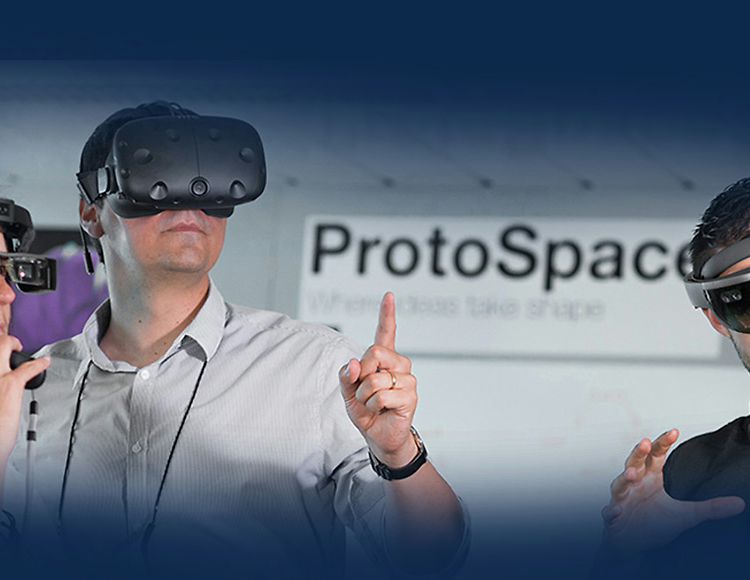Hype or game changer? A multidisciplinary team at Airbus is currently investigating the potential for the aviation industry of novel devices such as the Oculus Rift, Microsoft HoloLens and other new applications from the realm of virtual and augmented reality.
Spotting the potential
All at once, Mark Zuckerberg was transported to another world. He saw the ruins of a castle before his eyes and watched the snowflakes as they drifted down around him from the sky. When he turned around, he found himself confronted by a giant lava-spewing stone monster.
That’s what the Facebook founder saw when he first strapped an Oculus headset around his head. But he also spotted something else: the potential it held. In 2014 he bought Oculus for 2.3 billion USD, making Facebook one of the biggest players in the market – although not by a long chalk the only one. In addition to the Oculus Rift, devices such as HTC Vive, Samsung Gear VR, PlayStation VR or Google Cardboard transport their users into a 3D world.
Glasses and headsets for virtual reality (VR) and augmented reality (AR) are gaining in popularity, but what is this phenomenon really all about? Do these technologies have the potential to become a game changer? To answer this question, Airbus’ emerging technologies and concepts team is testing the new devices. Their task is to identify disruptive technologies in order to rapidly quantify their potential impact and benefits on the aerospace industry.
Current applications
“Virtual and augmented reality is nothing new for us,” says Alexandre Godin, in charge of the department’s VR and AR sections. Airbus, Airbus Helicopters and Airbus Defence and Space already have VR rooms where engineers work on artificial 3D objects for design purposes.
Airbus also uses AR inside aircraft to perform quality checks. And at Airbus’ Innovation Centre in Hamburg, the Company has developed 3D technology that allows customers to walk through a virtual aircraft cabin and decide on the spot what their A350 XWB cabin should look like, from the seats to lighting and carpets. Future add-ons include a tactile sensory feature that will allow customers to actually test out the level of comfort of the seats they have chosen for their new cabin.
Opportunities ahead
Where today we still need mobile phones or computers to enter the digital world, soon all we’ll need will be a pair of glasses that merges both physical and virtual worlds into a single space.
“What’s new is that VR and AR devices are becoming increasingly affordable, easy to handle and user friendly,” Godin explains. One particularly promising AR headset is Microsoft’s HoloLens. Unlike VR headsets such as the Oculus Rift, the HoloLens does not plunge the user into a 3D world; instead, AR brings virtual objects into the physical world, making them appear and behave as solid objects through advanced recognition of the user’s environment. For a viewer looking through the HoloLens, a living room floor becomes the surface of Mars or a wall is transformed into a television.
After having tested the headsets, Airbus decided to create a cross-divisional team of experts and sign a partnership agreement with Microsoft in November 2015. Through the partnership, the team has received extended access to headsets before their commercial release and is currently working on possible internal applications. In one scenario, cabin furnishings and fittings could be projected in the form of a hologram onto an empty aircraft cabin. Unlike the VR technology being used in the Innovation Centre in Hamburg, AR technology would enable customers to walk through the physical aircraft and customise the projected design with a simple swipe of a finger.
As soon as they looked through the HoloLens for the very first time, Godin and his colleagues recognised its potential for Airbus. “Where today we still need mobile phones or computers to enter the digital world, soon all we’ll need will be a pair of glasses that merges both physical and virtual worlds into a single space,” says Godin. This could have a radical impact not only on industry, but also on how we all live our lives, the way we communicate with each other, work, cook or watch television. “And that,” believes the 26-year-old, “definitely makes these technologies a game-changer, and a huge opportunity for Airbus.”
No pipe dream
VR and AR are reality, not dreams thought up by science fiction. Here’s how these technologies could revolutionise our lives:
Better perspective
Rock the stage with Katy Perry or kick it with Lionel Messi in the stadium: various providers are working on VR cameras and glasses that could allow fans to experience concerts and sport events from different perspectives.
Travel further
VR glasses already bring the Caribbean, New York or the Canadian wilderness right into your living room. With help from the Mars Rover, NASA is now working on delivering a VR application that lets you take a stroll across the red planet.
More advanced healing
A visit to the dentist won’t be replaced by VR and AR. But VR glasses could soon become an indispensable learning tool for doctors in training, in much the same way flight simulators are for future pilots. What’s more, surgeons could use AR glasses to display important patient information during surgery.
Improved learning
With VR glasses, students can travel to distant places or experience key historical moments. With AR glasses, trainees receive important tips and directions right in front of their eyes while performing difficult tasks for the first time alone.
Beata Cece
